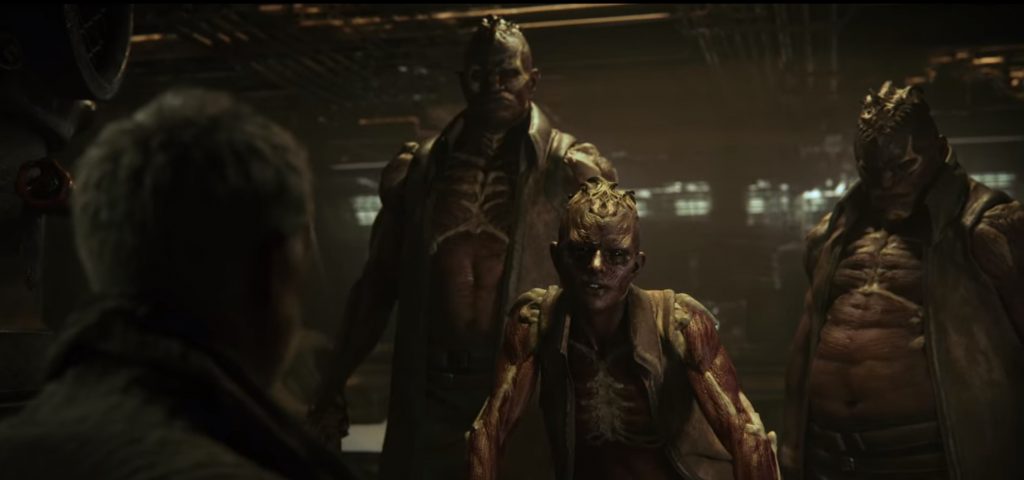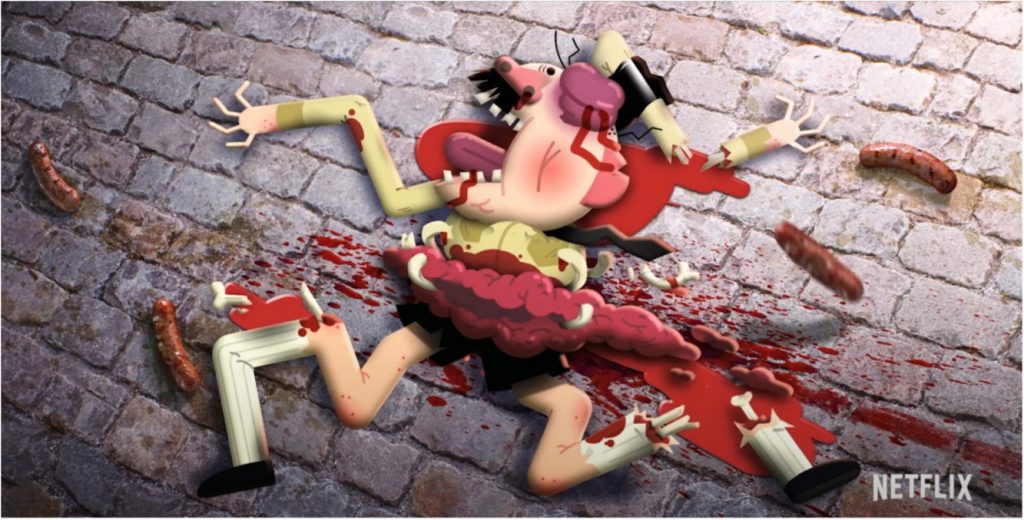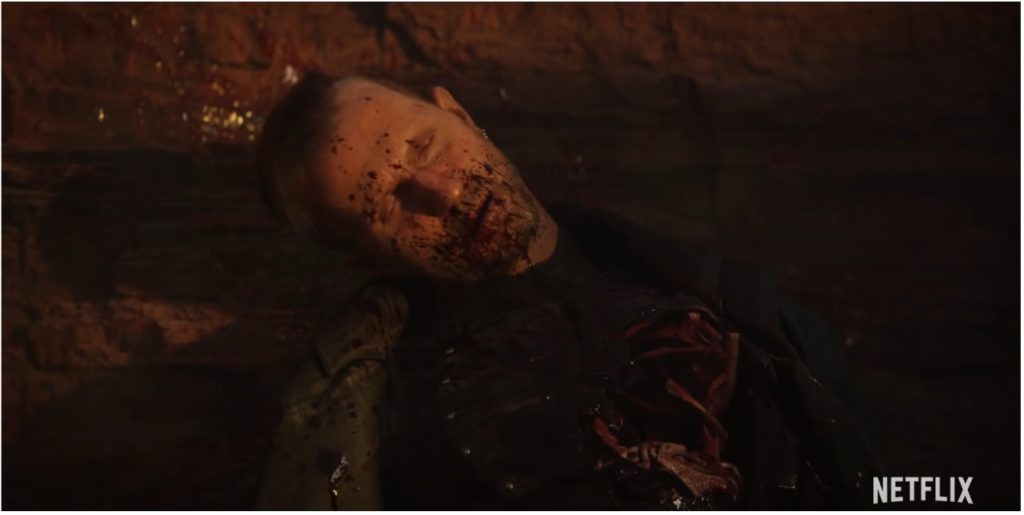The episode of the Netflix anthology series Love, Death, and Robots (2019-2021) titled “Snow in the Desert” follows a white-haired, middle-aged man named Snow as he traverses a dangerous alien landscape, pursued by human and alien bounty hunters. In a saloon reminiscent of the cantina in Star Wars: Episode IV – A New Hope (1977), three bounty hunters corner Snow. A shootout ensues, and heads and limbs are blown off in quick order. Blood and gore splattering the scene. Snow quickly bandages the severed stump of his right hand and makes for his home in the distant hills. Hours later, we see that his hand is already partially recovered, growing back like a starfish’s limb. This ability to regenerate, which holds the potential for immortality, is why he is being so intensely pursued.

From a childhood saturated with Looney Tunes and Saturday morning cartoons, I have long been fascinated with the way viewers receive or perceive animated depictions of physical violence. Although, in the end, this is highly subjective, informed by one’s cultural upbringing and personal experience, I am always curious as to whether any discernible patterns emerge. Is there, if not a predictable, at least a generalizable effect on perception depending on the film’s genre or visual style? Are there, if not rules, at least any rules of thumb that might apply when a filmmaker approaches a scene of violence intending a specific response from the audience?
When Chuck Jones was asked about the pain gags (the term for physical violence intended for humorous effect) in his cartoons, he stated that he avoided “describing the bloody bits.” Love, Death, and Robots, by contrast, is very much about showing the bloody bits. While all the stories fall under the shared genre umbrella of science fiction and fantasy (a debated distinction), they are produced in a wide variety of narrative and visual styles by several different animation and visual effects studios.
Most are not aiming for humor, or at least humor exclusively. These stories use images of violence to elicit fear, revulsion, anger, or satisfaction from their audience, even overlapping at times. In the climax of the aforementioned “Snow in the Desert,” the leader of the bounty hunters casually and brutally dispatches Snow’s partner. Snow is cornered, helpless until his partner re-emerges, literally yanking the villain’s heart out in gory retribution – a combination of a gross-out moment and fulfilling revenge. In short, this anthology series is a perfect sample from which to explore larger ideas about how filmmakers intentionally (or not) manipulate the levers of storytelling and visualization to provoke a specific response in the audience.
I spoke with the screenwriter of Love, Death, and Robots, Philip Gelatt, about the nature of violence in the series (see Beatty 2021). I was eager to tease out some of the thinking behind the decisions about how scenes of violent action were presented. According to Gelatt, in nearly all cases, these were collaborative decisions, involving Gelatt as a screenwriter, the directors, the producers, and the story artists, all responding to the short story source material.

In analyzing the episodes, and in conversation with Gelatt, it appears that rather than focusing on genre or style as the sole determinant of how scenes of physical violence are received (i.e., 2D violence is funny and 3D violence is not), it is more helpful to think of tone and audience cues. While it is true that much of the “humorous” violence is animated in 2D, it is not exclusively so. Some episodes employ a 3D approach that includes “cute” design or references classic stop-motion films. In these examples, the filmmakers can reasonably expect the audience to receive the violence as funny, even if it is bloody. It is the tone that drives choices in dialogue, music, and design. The appearance of the characters, the over-the-top premise, and the dialogue cue the viewer to not take this violence seriously. They suggest that it is okay to laugh at this, even though by all objective accounts, this is painful. These are just cartoons.

On the other hand, most episodes take a darker, more visceral approach to physical violence. The tone in these episodes is reinforced not only by the realistically detailed designs of the environment and characters but also by the way the filmmakers give attention to the details and subtleties of the character’s actions. By this, the audience is cued to treat this not as a cartoon, but as something akin to real-life. And this is not exclusive to the episodes produced in “realistic” 3D animation. There are haunting episodes of physical peril rendered in graphically striking 2D imagery.
Yet, I wonder if, in the end, there remains an unbelievability about any sort of animated physical violence, even as the gore becomes more and more “real.” Maybe this is because it resembles the latest generation of violent AAA video games (some of the episodes are produced by studios that also create video game cinematics and trailers). Video games, after all, are premised on the promise of many lives, the impermanence of death. And in that way, it is no different than the character Snow’s regenerating limb, or Wile E. Coyote’s persistently unfortunate outcomes for that matter. Animated violence can elicit real emotional responses like laughter or disgust, but do we ultimately treat it as unreal? That may not be a significant distinction, but perhaps, more importantly, it could serve as a reminder that animation’s unreality is precisely what allows it to be an infinitely adaptable medium for storytelling.
References
Barrier, Michael (1971). “An Interview with Chuck Jones.” Funnyworld 13; reprinted in M. Furniss (2005), Chuck Jones Conversations. Jackson: University Press of Mississippi.
Beatty, Geoffrey (2021), “Interview with Philip Gelatt.” 19 September.
Geoffrey Beatty received his undergraduate degree in animation from the University of the Arts, after which he worked for the MIT Media Lab creating animation for research into artificial intelligence and robotics. He was the founder and coordinator of Philadelphia University’s Animation program, as well as the inaugural faculty for Moore College of Art & Design’s Interactive and Motion Arts program. He is currently Assistant Professor of Digital Arts at La Salle University. He is also the owner and creative director of a small animation studio, Germantown Studios, creating animation for clients as diverse as Google, Target, Hermès, Hasbro, Novartis, and the Philadelphia Museum of Art.
